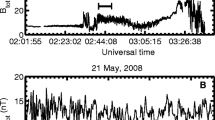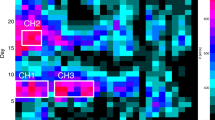Abstract
The magnetic field variations are analyzed in the range of time periods from 4 s to 240 s in the magnetosheath observed by the Double Star TC-1 and Cluster in 2004. The characteristics of the magnetic field fluctuations are strongly controlled by the angle between the upstream interplanetary magnetic field (IMF) and the normal of the bow shock. Generally speaking, the magnetic field fluctuations in the quasi-parallel magnetosheath are more intense than those in the quasi-perpendicular ones. Almost purely compressional waves are found in the quasi-perpendicular magnetosheath. With the increase of the local plasma β, both the magnitude and direction of the magnetic field fluctuate more intensely. There exists an inverse correlation between the local temperature anisotropy T ⊥/T∥ and the plasma β.
Similar content being viewed by others
References
Song P, Russell C T. What do we really know about the magnetosheath? Adv Space Res, 1997, 20(4–5): 747–765. doi:10.1016/S0273-1177(97)00466-3
Sckopke N, Paschmann G, Brinca A L, et al. Ion thermalization in quasi-perpendicular shocks involving reflected ions. J Geophys Res, 1990, 95(A5): 6337–6352
Gary S P. The mirror and ion-cyclotron anisotropy instabilities. J Geophys Res, 1992, 97(A6): 8519–8529
Gary S P, Fuselier S A, Anderson B J. Ion anisotropy instabilities in the magnetosheath. J Geophys Res, 1993, 98(A2): 1481–1488
Pokhotelov O A, Balikhin M A, Treumann R A, et al. Drift mirror instability revisited. 1. Cold electron temperature limit. J Geophys Res, 2001, 106(A5): 8455–8463. doi:10.1029/2000JA000069
Anderson B J, Fuselier S A, Gary S P, et al. Magnetic spectral signatures in the earth’s magnetosheath and plasma depletion layer. J Geophys Res, 1994, 99(A4): 5877–5891. doi:10.1029/93JA02827
Gary S P, Winske D. Simulations of ion cyclotron anisotropy instabilities in the terrestrial magnetosheath. J Geophys Res, 1993, 98(A6): 9171–9179
McKean M E, Winske D, Gary S P. Mirror and ion-cyclotron anisotropy instabilities in the magnetosheath. J Geophys Res, 1992, 97(A12): 19421–19432
Fuselier S A, Anderson B J, Gary S P, et al. Inverse correlations between the ion temperature anisotropy and plasma-beta in the earth’s quasi-parallel magnetosheath. J Geophys Res, 1994, 99(A8): 14931–14936. doi:10.1029/94JA00865
Song P, Russell C T, Thomsen M F. Waves in the inner magnetosheath—A case study. Geophys Res Lett, 1992, 19(22): 2191–2194
Fazakerley A N, Southwood D J. Mirror instability in the magnetosheath. Adv Space Res, 1994, 14(7): 65–68. doi:10.1016/0273-1177(94)90049-3
Engebretson M J, Lin N, Baumjohann W, et al. A comparison of ULF fluctuations in the solar-wind, magnetosheath, and dayside magnetosphere. 1. Magnetosheath morphology. J Geophys Res, 1991, 96(A3): 3441–3454
Fairfield D H. Magnetic-fields of magnetosheath. Rev Geophys, 1976, 14(1): 117–133
Shevyrev N N, Zastenker G N. Some features of the plasma flow in the magnetosheath behind quasi-parallel and quasi-perpendicular bow shocks. Planet Space Sci, 2005, 53(1–3): 95–102. doi: 10.1016/j.pss.2004.09.033
Spreiter J R, Summers A L, Alksne A Y. Hydromagnetic flow around the magnetosphere. Planet Space Sci, 1966, 14(3): 223
Carr C, Brown P, Zhang T L, et al. The Double Star magnetic field investigation: Instrument design, performance and highlights of the first year’s observations. Ann Geophys, 2005, 23(8): 2713–2732
Rème H, Dandouras I, Aoustin C, et al. The HIA instrument on board the Tan Ce 1 Double Star near-equatorial spacecraft and its first results. Ann Geophys, 2005, 23(8): 2757–2774
Balogh A, Carr C M, Acuna M H, et al. The Cluster magnetic field investigation: Overview of in-flight performance and initial results. Ann Geophys, 2001, 19(10): 1207–1217
Rème H, Aoustin C, Bosqued M, et al. First multispacecraft ion measurements in and near the Earth’s magnetosphere with the identical Cluster ion spectrometry (CIS) experiment. Ann Geophys, 2001, 19(10): 1303–1354
Shue J H, Chao J K, Fu H C, et al. A new functional form to study the solar wind control of the magnetopause size and shape. J Geophys Res, 1997, 102(A5): 9497–9511. doi:10.1029/97JA00196
Lin N, Engebretson M J, McPherron R L, et al. A comparison of ULF fluctuations in the solar wind, magnetosheath, and dayside magnetosphere. 2. Field and plasma conditions in the magnetosheath. J Geophys Res, 1991, 96(A3): 3455–3464
Chisham G, Schwartz S J, Balikhin M A, et al. AMPTE observations of mirror mode waves in the magnetosheath: Wavevector determination. J Geophys Res, 1999, 104(A1): 437–447. doi: 10.1029/1998JA900044
Song P, Russell C T, Thomsen M F. Slow mode transition in the frontside magnetosheath. J Geophys Res, 1992, 97(A6): 8295–8305
Song P, Russell C T, Gary S P. Identification of low-frequency fluctuations in the terrestrial magnetosheath. J Geophys Res, 1994, 99(A4): 6011–6025. doi:10.1029/93JA03300
Stone E C, Frandsen A M, Mewaldt R A, et al. The advanced composition explorer. Space Sci Rev, 1998, 86(1–4): 1–22. doi:10.1023/A:1005082526237
Denton R E, Anderson B J, Gary S P, et al. Bounded anisotropy fluid model for ion temperatures. J Geophys Res, 1994, 99(A6): 11225–11241. doi:10.1029/94JA00272
Author information
Authors and Affiliations
Corresponding author
Additional information
Supported by the CAS (Grant No. KJCX2-YW-T13) and the National Natural Science Foundation of China (Grant Nos. 40621003, 40628003, 40390150)
Rights and permissions
About this article
Cite this article
Du, J., Wang, C., Song, P. et al. Low-frequency fluctuations in the magnetosheath: Double Star TC-1 and Cluster observations. Sci. China Ser. E-Technol. Sci. 51, 1626–1638 (2008). https://doi.org/10.1007/s11431-008-0250-2
Received:
Accepted:
Published:
Issue Date:
DOI: https://doi.org/10.1007/s11431-008-0250-2




